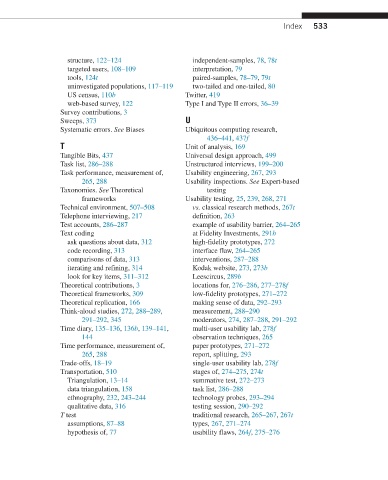Page 540 -
P. 540
Index 533
structure, 122–124 independent-samples, 78, 78t
targeted users, 108–109 interpretation, 79
tools, 124t paired-samples, 78–79, 79t
uninvestigated populations, 117–119 two-tailed and one-tailed, 80
US census, 110b Twitter, 419
web-based survey, 122 Type I and Type II errors, 36–39
Survey contributions, 3
Sweeps, 373 U
Systematic errors. See Biases Ubiquitous computing research,
436–441, 437f
T Unit of analysis, 169
Tangible Bits, 437 Universal design approach, 499
Task list, 286–288 Unstructured interviews, 199–200
Task performance, measurement of, Usability engineering, 267, 293
265, 288 Usability inspections. See Expert-based
Taxonomies. See Theoretical testing
frameworks Usability testing, 25, 239, 268, 271
Technical environment, 507–508 vs. classical research methods, 267t
Telephone interviewing, 217 definition, 263
Test accounts, 286–287 example of usability barrier, 264–265
Text coding at Fidelity Investments, 291b
ask questions about data, 312 high-fidelity prototypes, 272
code recording, 313 interface flaw, 264–265
comparisons of data, 313 interventions, 287–288
iterating and refining, 314 Kodak website, 273, 273b
look for key items, 311–312 Leescircus, 289b
Theoretical contributions, 3 locations for, 276–286, 277–278f
Theoretical frameworks, 309 low-fidelity prototypes, 271–272
Theoretical replication, 166 making sense of data, 292–293
Think-aloud studies, 272, 288–289, measurement, 288–290
291–292, 345 moderators, 274, 287–288, 291–292
Time diary, 135–136, 136b, 139–141, multi-user usability lab, 278f
144 observation techniques, 265
Time performance, measurement of, paper prototypes, 271–272
265, 288 report, splitting, 293
Trade-offs, 18–19 single-user usability lab, 278f
Transportation, 510 stages of, 274–275, 274t
Triangulation, 13–14 summative test, 272–273
data triangulation, 158 task list, 286–288
ethnography, 232, 243–244 technology probes, 293–294
qualitative data, 316 testing session, 290–292
T test traditional research, 265–267, 267t
assumptions, 87–88 types, 267, 271–274
hypothesis of, 77 usability flaws, 264f, 275–276

